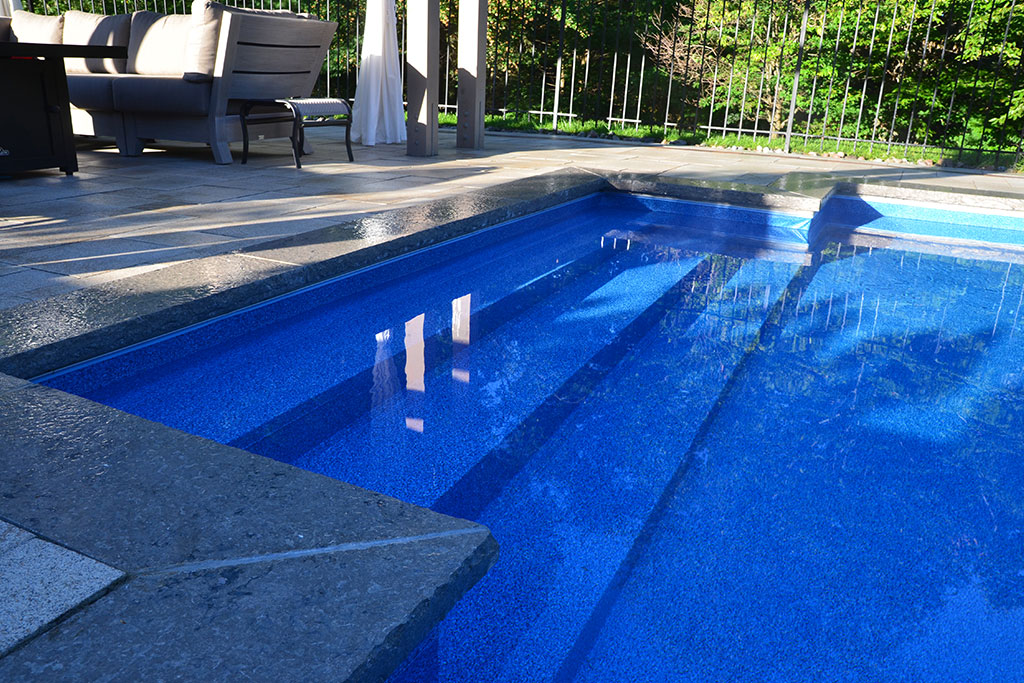
Marbelite is a mixture of white cement and white marble dust used as an interior pool finish designed for resurfacing gunite or shotcrete pools. It can be given a colour, quartz finish, glass bead finish or be left white. If you are looking to renovate your marbelite pool or build a new concrete pool, Blue Diamond can help.
Marbelite transforms ordinary concrete into a beautiful and practical surface, resistant to chemicals, algae and staining.
We feel it’s important to educate our clients about the best ways to maintain their new marbelite swimming pool surfaces, in an effort to ensure lasting results. Contact us here for more information.

Steps for Marbelite Application.
First, we apply a scratch/bond coat that needs to dry thoroughly before we apply the marbelite finish. Usually, this requires three to five days. Next, we will hand trowel the marbelite finish smoothly over the previous coat. It takes approximately a month for the marbelite finish to cure, during which proper maintenance is essential to keep it new looking and maintenance-free for years to come. Sometimes it is necessary to chip, or key, below the waterline’s tiles to avoid unsightly bulges before the swimming pool restoration process can be completed. If the marbelite finish is more than a half-inch thick, “keying” the tiles will help create a seamless, “feathered-in” look with the finished product resulting in a beautiful, smooth marbelite finish in your choice of colour.
View our Marbelite colours here with Pebbletec
Caring for Marbelite.
We feel it’s important to educate our clients about the best ways to maintain their new marbelite swimming pool surfaces, in an effort to ensure lasting results. Here are some helpful maintenance tips to get you started; but for a more in-depth look at Marbelite Care please click here.
- You should begin filling your pool with water immediately after we’ve installed the marbelite, unless you’ve been advised otherwise. You should also begin filtering the pool immediately to decrease calcium build-ups and to ensure proper pool circulation for chemical distribution.
- Ensure your pool’s filtration system is properly functioning at all times to maintain clear, sanitary water conditions.
- Whenever possible, only use name-brand products when treating your pool’s water. Don’t be tempted by cheaper imitation products that may contain damaging additives.
- Try to keep your marbelite surface wet and clean of debris. Please note that if some crazing should appear, it’s perfectly normal and will disappear after the marbelite has finished absorbing its moisture.
- For the first two weeks, you will need to clean your pool daily with a non-metallic brush and vacuum, but avoid using a vacuum with wheels that may scuff the surface.
- Your pool’s pH level may seem a little high for a few weeks, but be aware that this is normal. It should decrease with continued use. The desired pH level lies between 7.4 and 7.6. If it doesn’t decrease over time, contact us.
- When the pool is not being used for the season, be sure to cover it with a pool cover.
- Always try to keep the water’s level above your new marbelite finish to avoid crazing, delamination or discoloration.
Water Chemistry.
Water chemistry is the single most important aspect of maintenance to understand. If you have heavy amounts of metals (such as copper and iron) that have precipitated in your water, it may result in unsightly stains around your new marbelite finish. Contact us to find out what mineral-cancelling chemicals we recommend to help neutralize your water’s chemistry to prevent as much marbelite deterioration as possible. Please view the table below or visit the National Plasterers Council (NPC) for more information regarding marbelite’s chemistry characteristics.
pH 7.4 – 7.6
Cyanuric acid (stabilizer) Below 50 ppm
Alkalinity 80 – 120 ppm
Sequestering agent 10 – 20 ppm monthly
Free available chlorine (FAC) 1 – 3 ppm
Metals 0 ppm
Combined chlorine 0 ppm
Total available chlorine (TAC) Equal to free (represents 0 ppm combined)
Calcium hardness 200 – 400 ppm (below 250 for exposed aggregate)
Total dissolved solids (TDS) Below 1200 ppm or no more than 800 ppm above fill water
